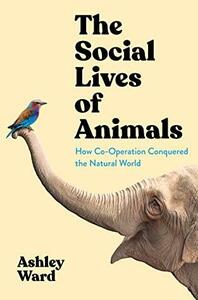You need to sign in or sign up before continuing.
Take a photo of a barcode or cover
27 reviews for:
The Social Lives of Animals: How Co-Operation Conquered the Natural World
Ashley Ward
27 reviews for:
The Social Lives of Animals: How Co-Operation Conquered the Natural World
Ashley Ward
funny
informative
***These are my random thoughts after finishing the book. Some of the thoughts are an overall review of the book, or any questions/feelings that nagged at me throughout. There will almost definitely be spoilers. Read at your own risk.*** ‐----------------------------------------------------------------------------------------------------
4 stars
Well-researched and paced
Fun to see a call-out to How To Speak Whale!
Really enjoyed the section about fish and shoals actually
4 stars
Well-researched and paced
Fun to see a call-out to How To Speak Whale!
Really enjoyed the section about fish and shoals actually
This was an entertaining book about how animals cooperate together. The author discusses everything from termites to great whales. He also discusses how he came to be a zoologist, and I am so jealous! It would be much more fun hunting for fish in a dirty pond than my well-paid desk job. Or so I like to think. I LOVED animals, observing them and sometimes killing them by mistake, when I was a child. I realized for example, when I was 9 years old, that if you do not feed your fresh-water crabs, they will kill the weakest and eat that one. I was horrified when I saw this and promptly let them all go. Possibly it was just over-crowding and not hunger, or a combination. A little earlier I had also learned about oxygen - and that guppies caught in the creek would not survive the night without some greenery in the glass jar. Maybe it's just as well I didn't become a zoologist, come to think of it.
Anyway, I digress. This is a brilliant book that shows that animal societies differ from ours by degree, not by kind. We aren't quite as unique as we would like to think, and a lot of traits have co-evolved with other creatures we evolved with. Empathy and reciprocity are traits we find in many other mammals, not just us. I wonder, that if we had not been so brain-washed through the ages, of being the pinnacle of creation, that we would take better care of the creatures we share the earth with. Less arrogant in the face of their distress.
Another example, also used in the book, but this from my current daily life. There are some beef cattle on a field near where I live. I've walked past a few times, talked to them, given them some grass (although there is grass in the field). The other day, I was walking past, stopped, and the cattle started to congregate. After five minutes or so, the cow tagged 4782 and with warts on her nose, came running and shoved the other ones out of the way to get closest to me. She remembered well that I was the one who had given her a treat a couple of weeks earlier. I don't eat beef. At least the beef calves get to stay with their mothers though, unlike dairy cows and calves.
Anyway, if you care at all about the other creatures we share this planet with, do read this book. Although a lot of it will be familiar, there will still be new material. Plus the author does a great job mixing seriousness with joviality.
Anyway, I digress. This is a brilliant book that shows that animal societies differ from ours by degree, not by kind. We aren't quite as unique as we would like to think, and a lot of traits have co-evolved with other creatures we evolved with. Empathy and reciprocity are traits we find in many other mammals, not just us. I wonder, that if we had not been so brain-washed through the ages, of being the pinnacle of creation, that we would take better care of the creatures we share the earth with. Less arrogant in the face of their distress.
Another example, also used in the book, but this from my current daily life. There are some beef cattle on a field near where I live. I've walked past a few times, talked to them, given them some grass (although there is grass in the field). The other day, I was walking past, stopped, and the cattle started to congregate. After five minutes or so, the cow tagged 4782 and with warts on her nose, came running and shoved the other ones out of the way to get closest to me. She remembered well that I was the one who had given her a treat a couple of weeks earlier. I don't eat beef. At least the beef calves get to stay with their mothers though, unlike dairy cows and calves.
Anyway, if you care at all about the other creatures we share this planet with, do read this book. Although a lot of it will be familiar, there will still be new material. Plus the author does a great job mixing seriousness with joviality.
funny
reflective
medium-paced
An excellent dive into how various social animals live and structure their societies - from plankton to chimps and bonobos, via termites, cockroaches, rats, naked mole rats, herring, whales, elephants, and others.
Ward writes with a passion for his subject (on several occasions slipping in anecdotes about encounters with various creatures form his childhood or career as a biologist), as well as a great deal of confident knowledge and humour.
Ward writes with a passion for his subject (on several occasions slipping in anecdotes about encounters with various creatures form his childhood or career as a biologist), as well as a great deal of confident knowledge and humour.
I am super enjoying all the recent books coming out on animal socialization and how complex it actually is. I appreciate books that don't attempt to frame everything with respect to human values/strong points in particular, which is one of the huge biases that is only now being overcome in research as well.
Interesting and entertaining, pop-science type book on the social lives of assorted animals.
funny
informative
inspiring
reflective
medium-paced
adventurous
informative
reflective
medium-paced
Infectious in his enthusiasm, and able to eke out a bounty of wry smiles with his dry British humour, Ward delivers a wildly fun traipse across multiple continents and species, as he describes encounters which illustrate the various different ways other animals lead social lives
Fun facts I learnt:
- Krill experience stress when far away from their group, and also when they see a predator (their heart rates increase)
- Bees
- Termites build incredibly large complexes with no human equivalent of urban planning.
- Some species of ants will raise a "flock" of aphids to get their sweet honeydew, even going so far as to build shelters for them, and move them to safety
- Termites and ants frequently go to war with each other; older soldiers are sent first as they are more dispensable, and termites will deliberately coat themselves in ant-saliva activated explosive chemicals to blow them all away
- Birds fly in V formation as the updraft formed from the ones in front helps support the ones behind and to the side, thus saving energy. This was studied by placing a bunch of birds into a wind tunnel
- Stickleback fish will make decisions on which path to take based on how many of their brethren are following one path, whether there's a predator there
- Birds appear to coordinate and use pooled knowledge when migrating together; studies have shown that when birds fly in groups they tend to take the shortest path and arrive the earliest, whereas singular birds will take longer and circle around for longer finding their bearings
- Jays have daycare (toddler chicks are left with a few parents while the rest forage)
- Rats develop food preferences based on mother's milk and what they themselves ate
Fun facts I learnt:
- Krill experience stress when far away from their group, and also when they see a predator (their heart rates increase)
- Bees
- Termites build incredibly large complexes with no human equivalent of urban planning.
- Some species of ants will raise a "flock" of aphids to get their sweet honeydew, even going so far as to build shelters for them, and move them to safety
- Termites and ants frequently go to war with each other; older soldiers are sent first as they are more dispensable, and termites will deliberately coat themselves in ant-saliva activated explosive chemicals to blow them all away
- Birds fly in V formation as the updraft formed from the ones in front helps support the ones behind and to the side, thus saving energy. This was studied by placing a bunch of birds into a wind tunnel
- Stickleback fish will make decisions on which path to take based on how many of their brethren are following one path, whether there's a predator there
- Birds appear to coordinate and use pooled knowledge when migrating together; studies have shown that when birds fly in groups they tend to take the shortest path and arrive the earliest, whereas singular birds will take longer and circle around for longer finding their bearings
- Jays have daycare (toddler chicks are left with a few parents while the rest forage)
- Rats develop food preferences based on mother's milk and what they themselves ate



